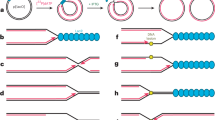Abstract
CHO cells were pulse labeled with 3H-thymidine after synchronization and blockage at the beginning of S phase for various intervals. The distribution of initiation sites for DNA replication and rates of chain growth were measured in autoradiographs prepared from these cells. Origins used for replication are widely distributed at or near the beginning of S phase, but usable origins increase continuously for many hours when FdU is used to block the synthesis of thymidylate. Potential origins are located about four microns apart, but in normal replication in these fibroblasts only one in 15 to 20 potential origins are used for initiation. On the other hand, when cells are held at the beginning of S phase for 12–14 h, about one-half of the potential origins are activated in part of the DNA and utilized when the cell is released from the block by supplying 3H-thymidine (10−6M). Chain growth during a short pulse decreases with time of the blockage at what appears to be a linear rate. However, cells can replicate long continuous stretches of their DNA with only 2×10−8M thymidine available in the medium for several hours when synthesis is blocked by FdU. The total amount of DNA replicated is, however, much less than when a concentration of 10−6 M thymidine is supplied for the same period. The origins which are finally used under any experimental condition appear to be a random sample of the total potential origins which are distributed in a regular repeating sequence along the DNA at about 12 kilobase intervals.
Similar content being viewed by others
References
Amaldi, F., Carnevali, F., Leoni, L., Mariotti, D.: Replicon origins in Chinese hamster cell DNA. Exp. Cell Res. 74, 367–374 (1972)
Blumenthal, A.B., Kriegstein, H.J., Hogness, D.S.: The units of DNA replication in Drosophila melanogaster chromosomes. Cold Spr. Harb. Symp. quant. Biol. 38, 205–223 (1974)
Callan, H.G.: Replication of DNA in the chromosomes of eukaryotes. Proc. roy. Soc. (Lond.) B 181, 19–41 (1972)
Kurek, M.P., Taylor, J.H.: Replication of DNA in mammalian chromosomes. IV. Partial characterization of DNA fragments released from replicating DNA of CHO Cells. Exp. Cell Res. 104, 7–14 (1977)
Ockey, C.H., Saffhill, R.: The comparative effects of short-term DNA inhibition on replicon synthesis in mammalian cells. Exp. Cell Res. 103, 361–373 (1976)
Taylor, J.H., Adams, A.G., Kurek, M.P.: Replication of DNA in mammalian chromosomes. II. Kinetics of 3H-thymidine incorporation and the isolation and partial characterization of labeled subunits at the growing point. Chromosoma (Berl.) 41, 361–384 (1973)
Taylor, J.H., Hozier, J.C.: Evidence for a four micron replication unit in CHO cells. Chromosoma (Berl.) 57, 341–350 (1976)
Wolstenholme, D.R.: Replicating DNA molecules from eggs of Drosophila melanogaster. Chromosoma (Berl.) 43, 1–18 (1973)
Author information
Authors and Affiliations
Rights and permissions
About this article
Cite this article
Taylor, J.H. Increase in DNA replication sites in cells held at the beginning of S phase. Chromosoma 62, 291–300 (1977). https://doi.org/10.1007/BF00327029
Received:
Issue Date:
DOI: https://doi.org/10.1007/BF00327029




